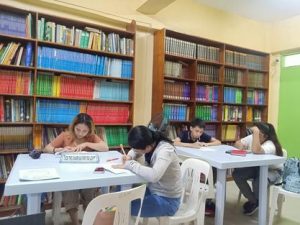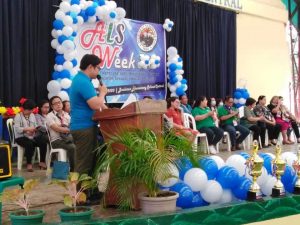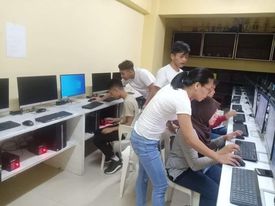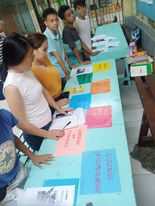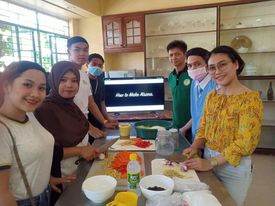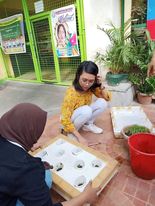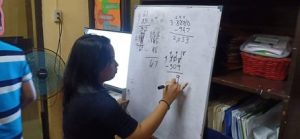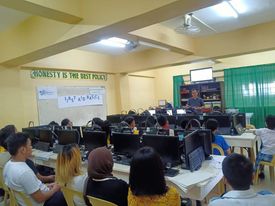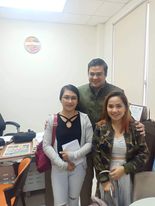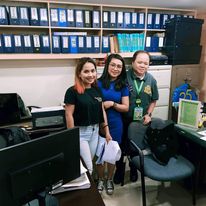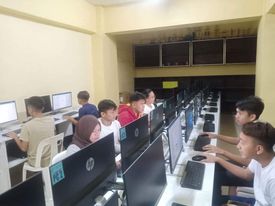Alternative Learning System
The Alternative Learning System (ALS) is a ladderized, modular non-formal education program in the Philippines for dropouts in elementary and secondary schools, out-of-school youths, non-readers, working Filipinos and even senior citizens. It is part of the education system of the Philippines but an alternative to the regular classroom studies where Filipino students are required to attend daily. The alternative system only requires students to choose schedules according to their choice and availability.
The program has two different schematics for conducting instruction; school-based and community-based. On the school-based program, instructions are conducted in school campuses while in the community-based program, formal instruction is conducted in community halls or in private places. The ALS program follows uniform lesson modules for all academic subjects covering the sciences, mathematics, English, Filipino, social studies, current events among others. Delivery of instructions is provided by government-paid instructors or by a private non-government organization.
Aside from schematics, the program has two levels; elementary and secondary. Students have to start from the elementary level, then proceed to the high school level. If a student is a graduate of elementary under a formal classroom system, the student is automatically admitted to the secondary levels depending on which year level the student stopped schooling.
Administration
Program administration is held by the Department of Education, an agency of the government of the Philippines in charge of providing education to all Filipinos. A private non-government organization may deliver the program but still under the supervision of the Philippine education agency.
After finishing the curriculum, all participants of the program belonging to a particular education district are given the final comprehensive examinations covering all subject areas in the curriculum. Successful examinees are then grouped together in a closing ceremony where they gave their certificate of completion either for the elementary or secondary level.
Levels
Elementary Level
If a student has never reached the first grade, the student will be admitted in the Grade 1 level with the corresponding module of instruction given. The students have to finish all the modules for the first-grade level and pass an assessment test before proceeding to the next level. After successfully finishing all the modules, the students are given comprehensive examinations prior to admission at the secondary level.
High school or Secondary Level
The procedure for the secondary level is the same as the elementary level. Once the student graduated at the secondary level, he or she may opt to enroll in the tertiary level without the need for attending the formal classroom system, hence the name alternative learning system. Normally, under the education system of the Philippines, no student is allowed to enter the tertiary level of education without a high school diploma. The alternative system is the other path and opportunity to access vocational technology or college education in the Philippines.
Coverage
The program covers mostly dropouts in elementary and secondary schools, out-of-school youths, non-readers, working people and even senior citizens wanting to read and write. Students enrolled in the classroom system are barred from participating in the program. Age level, economic and personal circumstances are among the determinants in availing the program.
In Comparison with Formal Education[edit | edit source]
The ALS evolved from the non-formal education that has been conducted by the government of the Philippines. Previously, non-formal education was mostly concentrated in instructions in livelihood skills training with basic reading and writing incorporated in the module. Under the current system, skills training and livelihood training have been excluded and established as a separate education system. Skills training had become a stand-alone program with the Technical Education and Skills Development Authority (TESDA) taking charge of the program.
The ALS is a way for the informal and busy students to achieve elementary and high school education without the need of going to attend classroom instructions on a daily basis just like the formal education system. Secondary education has now become a prerequisite in vocational technology and college education in the Philippines. Livelihood training, however, does not need formal or non-formal education in the Philippines.
VISION
“Empowerment of the Filipino with desirable knowledge, attitudes, values, and skills that will enable him to think critically and creatively, act innovatively and humanely in improving the quality of his life and that of his family, community and country.”
MISSION
“It is envisioned that with the help of Alternative Learning System (ALS), every Filipino will be awakened, empowered and transformed into a productive, self-reliant, responsible, humane and upright citizen who can contribute to the betterment of the family, community and country. It is also envisaged that ALS will help alleviate poverty and sustain social and economic growth via the development of employable skills and the generation of self-employment.”
ALS A&E Test
The ALS Accreditation and Equivalency (ALS A&E)
test aims to offer learners two learning achievement at two learning levels – Elementary and Secondary.
It is a paper and pencil-based test, using multiple choice and composition writing. The test items are based on the learning competencies of the six learning strands of the ALS Curriculum.
What is ALS?
The ALS is a free education program implemented by the Department of Education (DepEd) under the Bureau of Alternative Learning System (BALS) which benefit those who cannot afford formal schooling and follows whatever is their available schedule. The program provides a viable alternative to the existing formal education instruction, encompassing both the non-formal and informal sources of knowledge and skills.
Objective
ALS aims to open more educational opportunities for Filipino citizens of different interests, capabilities of demographic characteristics, socioeconomic origin and status as well as addressing the needs of marginalized groups.
The program cuts the time needed to finish elementary or high school, hence, it significantly cuts the expenses as well. Aside from giving hope to the less fortunate, it also provides opportunities to Out-of-School Youths (OSY) and adults elementary and secondary school drop-outs; industry-based workers; domestic engineers; maids; factory workers; drivers; member of cultural minorities; indigenous people and person with disabilities challenged.
Training for instructional managers and coordinators are also providing by the program and supports the learner’s accreditation and equivalency (A&E) reviews.
How does it work?
In ALS, students have to attend 10 months of school or 800 hours in the classroom. Then their performances are then assessed.
Since ALS is module-based learning, students come in on a set time and choose a module to read. A quiz is given after each module to test their learning. Instead of teachers, facilitators are always present to answer any questions and sometimes lecturers would discuss a certain module. After several months the students will take the Accreditation and Equivalency Test (A&E Test). If they pass the test, they will be given an elementary or a high school diploma.
